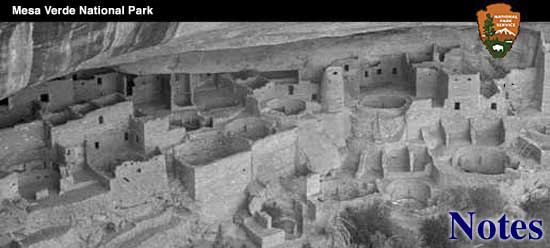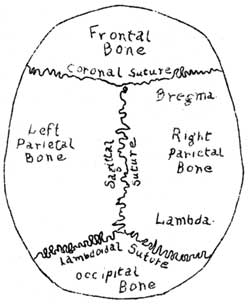

|
Although the average person is very likely to think of the skull as being made up of one large bone, the most casual inspection reveals that this is not the case. The skull cap or brain covering consists of four separate bones. These are known as the frontal bone, the right and left parietal bones, and the occipital bone. The lines where these bones meet are known as sutures. The coronal suture lies between the frontal bone and the two parietals, the sagittal suture lies between the two perietals, while the lambdoidal suture is between the parietals end the occipital bone. In this study of the sutures two points on the skull are important; bregma, the point where the sagittal suture meets the coronal, and lambda, the point where the saggital suture meets the lambdoidal. 
The sutures provide much information for the physical anthropologist. As long as the brain is growing the sutures remain open, and being of cartilaginous tissue they permit the brain case to increase in size. During the latter part of adult life, after the brain has ceased to grow, the sutures become ossified. The cartilaginous tissue is replaced by bone and the different bones of the skull become rigidly fastened together. The time of closure is earlier in some parts of the sutures than in others, and since the order of closure is fairly well known it provides a means by which the age of an individual may be estimated from the skull. Then too, as the brain grows, the sutures change, and the nature and amount of this growth and change seem to be related to racial types. As a general rule: "In the skull of the negro the posterior (lambdoidal) suture is most complex; in the Caucasian, the frontal (coronal) suture; while in the Mongoloid it is the one along the mid-line of the skull (the sagittal)."1
This is not an infallible indication. It is not at all uncommon to find individuals in whom the configuration of the sutures is at variance with the other racial indications of the skull. But for a long series the information of the sutures will usually hold good as a racial criterion, and in determining race, the relative complexity of the sutures is ordinarily taken into consideration. However, the skulls of the Mesa Verde cliff dwellers depart distinctly from this generalization. Thirty-nine skulls in the Mesa Verde collection were examined. Of these, seven could not be used, three being juvenile and four having the sutures so well closed that determination of complexity was impossible. As might be expected all showed simple coronal sutures. The other sutures, however, varied as is shown in the following table:
Two other observations were made. For one point, in these skulls sutural development was by regions more than along the lines of the sutures. All had very simple sutures in the region of bregma, and considerable more complexity in the region of lambda. It was frequently noted that the sagittal suture would be very simple at bregma but as lambda was approached it would become very complex. The same was true of the lambdoidal suture; it would be simple towards the ends but complex in the region of lambda. It was this condition that usually accounted for the skulls being classified as having equally complex sagittal and lambdoidal sutures. It seems very likely that there is some relationship between this condition and the occipital deformation characteristic of all the skulls, but since we have no undeformed cliff-dweller skulls it is impossible to say whether the complexity around lambda is entirely due to the deformation or whether it is natural. For a second point, out of the thirty-nine skulls, there were sixteen, or 41 percent, with Wurmian bones along the lambdoidal suture, including seven, or 18 per cent, with an Os Inca. It is possible that this factor was also caused by the artificial deformation. The relative complexity of the sutures cannot be measured metrically so observations are necessarily based on the judgment of the observer. The intent of this paper is merely to point out that the skulls of the cliff dwellers appear to depart from a common generalization on racial type in respect to sutural complexity. As the cliff-dwellers are generally considered to have been Mongoloid it would seem that the sagittal suture should show the greatest complexity. In the majority of cases this is not the case. Although the results may point to it, it should not be concluded that there was a Negroid strain in the cliff-dwellers. While this is possible it would be entirely incorrect to draw such a conclusion from only one criterion, that criterion being one that is not too well established as being dependable and invariable. | ||||||||||||||||||
| <<< Previous | > Cover < | Next >>> |
vol7-1b.htm
14-Oct-2011